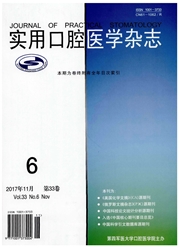

 中文摘要:
中文摘要:
目的:比较不同镀膜钕铁硼磁体在模拟口腔环境下的抗腐蚀性能。方法:将未镀膜、氮化钛镀膜、类金刚石镀膜钕铁硼磁体(每组45个)在37℃人工唾液环境下浸泡60d,每瓶100ml含磁体5个,并于浸泡之日起每10天从每瓶吸取1ml浸泡液,以电感耦合等离子体发射光谱法(ICP-AES)测定其内铁离子浓度。浸泡结束后比较各组磁体浸泡前后质量变化占原质量的百分比。结果:氮化钛镀膜组和类金刚石镀膜组浸泡液中的铁离子浓度在10、20、30、40、50、60d各时间点上均低于未镀膜组(P〈0.01),氮化钛镀膜组和类金刚石镀膜组浸泡前后质量差与初始质量的百分比低于未镀膜组(P〈0.01);镀膜组之间2项指标差异无统计学意义(P〉0.05)。结论:氮化钛镀膜和类金刚石镀膜均能增加钕铁硼磁体的抗腐蚀性能。
 英文摘要:
英文摘要:
Objective: To compare the corrosiveness resistance property of NdFeB magnet with different coatings in simulated oral en- vironment. Methods: 3 groups of magnets(45 in each group) bare magnets, magnets with titanium-TiNride (TIN) coating and magnets with diamond like carbon (DLC) coating were respectively immersed in the artificial saliva at 37℃ for 2 months. Each bottle contained 5 magnets in 100 ml of the artificial saliva. 1 ml of soak solution was taken from each bottle every 10 days after immersion. Inductively coupled plasma atomic emission spectrometry (ICP-AES) method was conducted to analyze the concentration of ferrous ion in the extractions. After immersion, the ratio of weight change to its original weight in each group was calculated and compared. Re- suits: The concentrations of ferrous ion in both TiN and DLC coating g~oups were lower than that in bare magnet group at each time- points ( 10, 20, 30, 40, 50 and 60 days) (P 〈 0.01 ). The concentrations of ferrous ion between TiN and DLC coating groups were not statistically different( P 〉 0:05 ). The ratios of weight change in TiN and DLC coating groups were not statistically different (P 〉 0.05 ) but lower than that in bare magnets group(P 〈 0.01 ). Conclusion: Both TiN coating and DLC coating can enhance its corrosiveness resistance property.
 同期刊论文项目
同期刊论文项目
 同项目期刊论文
同项目期刊论文
 期刊信息
期刊信息
